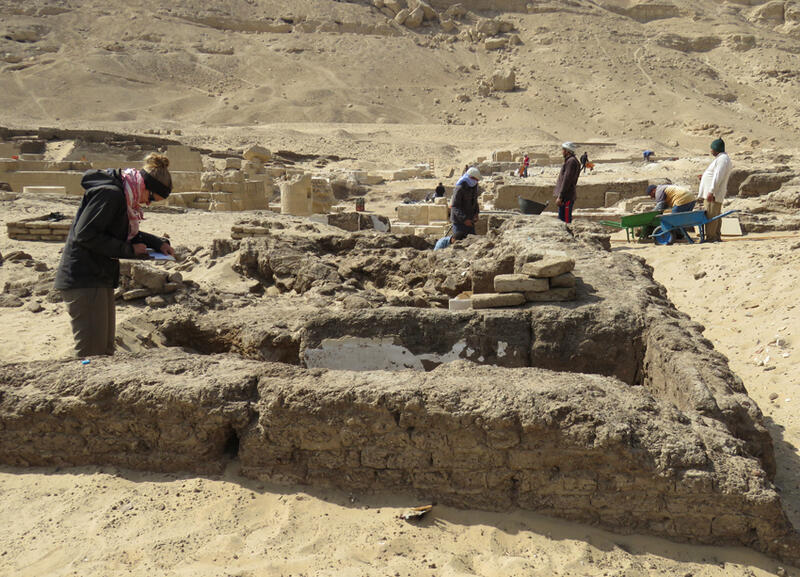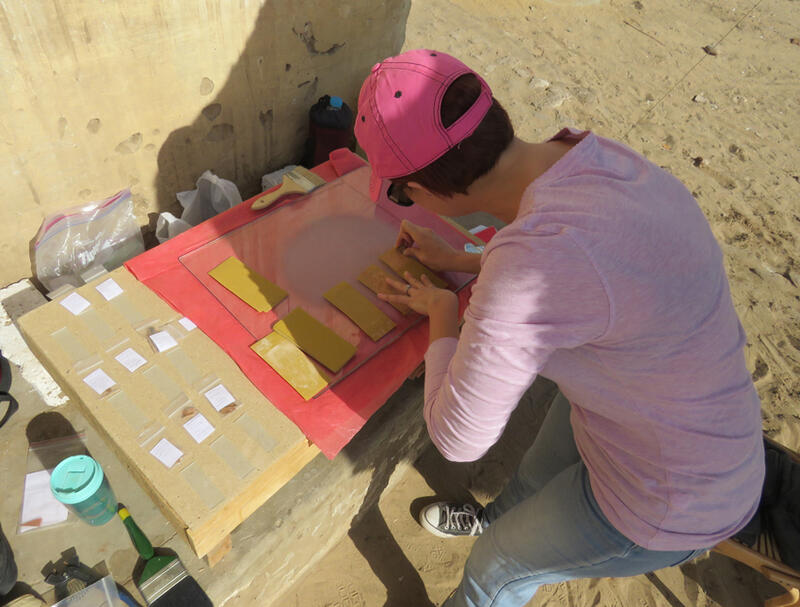Six-Pillared Hall
The Six-Pillared Hall is located in the northeast part of the site outside the temple enclosure and is built against its eastern enclosure wall, which it shares with the Refectory.
First described by Jacek Kościuk in his architectural survey, who noted that it was probably built into a courtyard,[1] the Six-Pillared Hall (fig. 1) was chosen by YMAP-South for excavation because its location and visible features, especially the limestone capitals of its piers, were consistent with other structures belonging to Christian Atripe. Its small size, well-defined shape, and apparently undisturbed deposits were also taken into consideration as factors of selection.

Figure 1. Six-Pillared Hall (lower left) and Refectory (right) as they appeared in 2017, looking south.
The building was excavated (figs. 2–3) between 2016 and 2018 by Louise Blanke and Wendy Dolling, who were assisted by Sharif Munir Adly, Daniel Eastman (2016), and Christopher West (2017), with digital archaeological recording by Alberto Urcia (2016–2018) and epigraphic analysis by Stephen Davis (2016–2019).

Figure 2. Louise Blanke recording excavated features within the Six-Pillared Hall in 2016.

Figure 3. Excavation of the Six-Pillared Hall in 2017 by Wendy Dolling, Adel Samir Labib, Reda Marzouk Aziz, Sharif Munir Adly, and Nady Aid Ghula, with Medhat Butros Bushra in the distance.
Pottery, objects, glass, and architectural elements associated with the Six-Pillared Hall were studied by Gillian Pyke (2016–2020), with assistance from Andrea Achi (ceramics, 2019), Mary Farag (objects, 2016), Stéphanie Machabée (objects, 2016–2017), Sharif Munir Adly (all categories, 2018–2020), Hanna Maher Matta (all categories, 2018–2020), and Adel Samir Labib (all categories, 2018–2019).[2] Petrographic analysis of ceramic fabrics (fig. 4) was conducted by Mary Ownby (2018).[3] Archaeozoological materials were assessed by Salima Ikram (2019), and archaeobotanical analysis will be conducted by Mennat-Allah El Dorry.[4] Together these specialist studies provide a picture of the appearance and function of this building, as well as when it was abandoned and what happened to it thereafter.

Figure 4. Mary Ownby thinning pottery samples from the Six-Pillared Hall for petrographic analysis in 2018.
The construction and organization of the Six-Pillared Hall (fig. 5) show that it belonged to the Christian rather than the Ptolemaic-Roman phase of activity at the site.[5] The large rectangular room was built of mud bricks, with fired bricks employed in the lower courses of the piers and limestone employed for the upper elements of the six rectangular piers supporting the barrel-vaulted roof (fig. 6). The doorway, located at the west end of the north wall, provided easy access to the Refectory and Trapezoidal Room, both located on the other side of the former enclosure wall, via separate staircases. The upper coat of the smooth, durable plaster floor contained brick dust that improved its water-resistance. White-plastered walls, piers, and ceiling enhanced the natural/artificial light. The white surfaces also provided the ground for wall writings (dipinti) in Coptic script, some of which include the names and titles of female monastics. [6]

Figure 5. Fully excavated Six-Pillared Hall with ceramic storage installations against the western piers (lower) and pilaster (lower right).

Figure 6. Articulated section of roof vault (centre) excavated by Wendy Dolling (top left, with Reda Marzouk Aziz) in the south part of the Six-Pillared Hall in 2017.
A striking feature of the Six-Pillared Hall is its ceramic installations, which consist of large, deep ceramic vessels in plaster-coated brick emplacements, set against the faces of several of the piers on its western side (fig. 7). These perhaps provided secure, dry, and thermally-stable storage for foodstuffs. They are notably similar to examples in the north part of the Refectory, also positioned against piers. Repairs to the floor and multiple coats of whitewash on the walls and piers speak to a period of use that was long enough to require maintenance. The absence of any reconfiguration suggests continuity in the Six-Pillared Hall’s function.

Figure 7. View of the northern half of the Six-Pillared Hall on completion of excavation in 2016, looking west. The circular ceramic installation (top left) is built against the north face of the west central pier.
Materials left behind when the Six-Pillared was eventually abandoned provide a sense of what activities took place here, at least at the end of its life. They also offer clues to when, if not why, these activities ceased. The ceramic and glass assemblages include vessels for food preparation and storage, which probably took place here, as well as those for cooking and dining, which were used elsewhere. The same is true for the now very fragmentary copper (alloy?) vessels. Petrographic analysis confirmed that some of the dining vessels were produced in the Aswan region. While most containerized food commodities came from within Egypt, a few were obtained from Tunisia (LRA 8; fig. 8), Cyprus (LRA 1), and the east Mediterranean seaboard (LRA 4).[7] Food items in evidence do not seem to have included meat, fish, or poultry, which would suggest that either they were initially prepared elsewhere or their consumption was restricted by the rules of the monastic federation.[8] The range of edible plants has yet to be established.

Figure 8. Tunisian Spatheion amphora, encrusted in its contents, found in the Six-Pillared Hall in 2018.
Well-known pottery and glass types place these activities somewhere in the later sixth to seventh centuries, with the coins suggesting that the Six-Pillared Hall remained in use to the later part of the seventh century. Once abandoned, the episodic collapse of the building’s barrel-vaulted mud-brick roof was interspersed with periods during which the building filled with windblown sand. According to ceramic finds (fig. 9), heavy pitting of the resulting rubble seems to have begun in ninth century.

Figure 9. Fragment of an eighth- to ninth-century late form of LRA 7, found in a post-abandonment deposit in the Six-Pillared Hall in 2017.
[1] J. Kościuk, “The Architectural Record. A General Description of the Individual Areas of the Town and Their Monuments,” in Athribis I, General Site Survey 2003–2007, Archaeological & Conservation Studies. The Gate of Ptolemy IX: Architecture and Inscriptions, ed. R. El-Sayed and Y. El-Masry (Cairo 2012), 108, figs. 2.3.10 and 2.3.11.
[2] For an introduction to the study of ceramics see C. Orton, and M. Hughes, Pottery in Archaeology, second edition (Cambridge: Cambridge University Press, 2013); D. Arnold and J. Bourraiu, An Introduction to Ancient Egyptian Pottery (Deutsches archäologisches Instituts Abteilung Kairo Sonderschrift 17; Mainz am Rhein: Philipp von Zabern, 1993). For the ceramic material from University of Tübingen excavations at Atripe, see G. Pyke, “The Ceramic Material from Athribis: The 2007/8–2010/11 Excavation Seasons,” in Athribis V, Archäologie im Repit-Tempel zu Athribis 2012–16, ed. M. Müller, M. el-Bialy, and M. Boraik (Cairo: Institut français de l’archéologie orientale, 2019), 221–294; and G. Pyke, “The Ceramic Material from Athribis: The 2012/13–2014/15 Excavation Seasons,” in Athribis V, 295–362. For an introduction to the study of objects, see L. Hurcombe, Archaeological Artefacts as Material Culture (Abingdon and New York: Routledge, 2007); B. Olsen, M. Shanks, T. Webmoor, and C. Witmore, Archaeology: The Discipline of Things (Berkeley: University of California Press, 2012). For photography and illustration of objects (including pottery and glass), see L. J. Fisher, Photography for Archaeologists, Part II: Artefact Recording, BAJR Practical Guide Series 26, 2009, published online, available at http://www.bajr.org/BAJRGuides/26.%20Artefact%20Photography%20in%20Archaeology/26ArtefactPhotographyforArchaeologists.pdf; and T. Small, Archaeological Illustration: Small Finds, BAJR Practical Guide Series 32, 2013, published online, available at http://www.bajr.org/BAJRGuides/32.%20Archaeological%20Illustration%20-%20Small%20Finds/Guide32.pdf. For an introduction to the study of glass, see K. H. A. Janssens, Modern Methods for Analysing Archaeological and Historical Glass (Hoboken: Wiley 2013); and J. Henderson, Ancient Glass: An Interdisciplinary Exploration, third edition (Cambridge: Cambridge University Press, 2013).
[3] For an introduction to ceramic petrography, see P. S. Quinn, Ceramic Petrography: The Interpretation of Archaeological Pottery and Related Artefacts in Thin Section (Oxford: Archaeopress, 2013); I. S. Druc, M. A. Masucci, and M. F. Ownby, eds., Integrative Approaches in Ceramic Petrography (Salt Lake City: University of Utah Press, 2017); M. F. Ownby, “Petrographic Analysis of Egyptian Ceramic Fabrics in the Vienna System,” in Vienna 2 – Ancient Egyptian Ceramics in the 21st Century, Proceedings of the International Conference Held at the University of Vienna, 4th–18th of May, 2012, ed. B. Bader, C. M. Knoblauch, and E. C. Köhler (Orientalia Lovaniensia Analecta 245, Leuven: Peeters 2016), 459–460.
[4] For an introduction to aspects of zooarchaeology, see A. M. Biesaw, Identifying and Interpreting Animal Bones: A Manual (College Station: Texas A&M University Press, 2013); S. Ikram, Choice Cuts: Meat Production in Ancient Egypt (Orientalia Loveniensia Analecta 69; Leuven: Peeters, 1995); and H. Russ, Introduction to Archaeological Fish Remains, BAJR Practical Guide Series 29, 2009, published online, available at http://www.bajr.org/BAJRGuides/29.Introduction%20to%20archaeological%20fish%20remains/29FishGuide.pdf. On animal remains from Egyptian monastic sites in Egypt, see D. Brooks Hedstrom, S. J. Davis, T. Herbich, S. Ikram, D. McCormack, M.-D. Nenna and G. Pyke, “New Archaeology at Ancient Scetis: Survey and Initial Excavations at the Monastery of St. John the Little in the Wādi al-Naṭrūn,” Dumbarton Oaks Papers 64 (2010), 224–225; R. M. Luff, “Monastic Diet in Late Antique Egypt: Zooarchaeological Finds from Kom el-Nana and Tell el-Amarna, Middle Egypt,” Environmental Archaeology 12 (2007), 161–174; W. Van Neer, W. Wouters, M.-H. Rutschowscaya, A. Delattre, D. Dixneuf, K. Desender, and J. Poblome, “Salted Fish Products from the Coptic Monastery at Bawit, Egypt: Evidence from the Bones and Texts,” in The Role of Fish in Ancient Times, ed. H. Hüstor Plogmann (Rahdan: Verlag Marie Leidorf, 2007), 147–159. For an introduction to archaeobotanical remains at late antique monastic sites in Egypt, see W. Smith, Archaeobotanical Investigations of Agriculture at Late Antique Kom el-Nana (Tell el-Amarna) (Egypt Exploration Society Excavation Memoir 70; London: Egypt Exploration Society, 2003).
[5] This was first observed by Jacek Kościuk: see Kościuk, “Architectural Record,” in Athribis I, 108, figs. 2.3.10 and 2.3.11.
[6] For the dipinti here and in the Refectory, see S. J. Davis, “Anastasia, Thecla, and Friends: Archaeological and Epigraphic Evidence from the Shenoutean Women’s Monastery at Atripe,” Le Muséon 133.3–4 (2020), 259–287.
[7] For Egyptian transport vessels of this period, see D. Dixneuf, Amphores égyptiennes, production, typologie, contenu et diffusion (IIIe siècle avant J.-C.–IXe siècle après J.-C.) (Études Alexandrines 23; Alexandria: Centre d’études alexandrines, 2011. For the LRA system, established at Carthage, see J. A. Riley, “The Coarse Pottery from Berenice,” in Excavations at Sidi Khrebish Benghazi (Berenice). Volume II, Economic Life at Berenice, Supplements to Libya Antiqua V, ed. J. A. Lloyd (Tripoli: Department of Antiquities, 1979), 91–263; J. A. Riley, “The Pottery from Cisterns 1977.1, 1977.2, and 1977.3,” in Excavations at Carthage 1977 Conducted by the University of Michigan, volume 6, ed. J. H. Humphrey (Ann Arbor: University of Michigan, 1981), 86–124. For a searchable database of Roman to late antique Mediterranean transport vessels, see the University of Southampton’s Roman Amphorae: A Digital Resource, available at https://archaeologydataservice.ac.uk/archives/view/amphora_ahrb_2005/.
[8] On textual evidence for the local monastic diet, see B. Layton, “Social Structure and Food Consumption in an Early Christian Monastery: The Evidence of Shenoute’s Canons and the White Monastery Federation A.D. 385–465,” Le Muséon 115 (2002), 44–45, table 3. On meat preparation in ancient Egypt, see Ikram, Choice Cuts.
